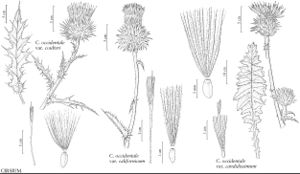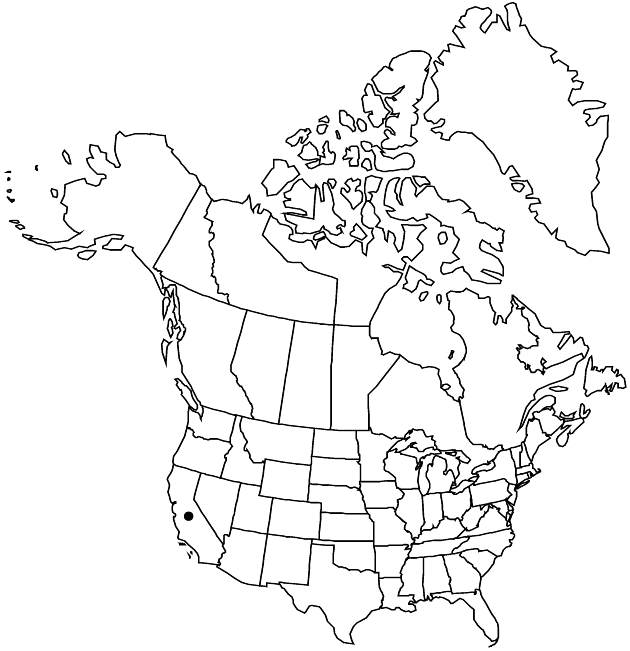Difference between revisions of "Cirsium occidentale var. californicum"
Phytologia 73: 315. 1992.
FNA>Volume Importer |
FNA>Volume Importer |
||
| Line 15: | Line 15: | ||
|name=Cirsium bernardinum | |name=Cirsium bernardinum | ||
|authority=(Greene) Petrak | |authority=(Greene) Petrak | ||
| − | }}{{Treatment/ID/Synonym | + | }} {{Treatment/ID/Synonym |
|name=Cirsium californicum var. bernardinum | |name=Cirsium californicum var. bernardinum | ||
|authority=(Greene) Petrak | |authority=(Greene) Petrak | ||
| − | }}{{Treatment/ID/Synonym | + | }} {{Treatment/ID/Synonym |
|name=Cirsium californicum subsp. pseudoreglense | |name=Cirsium californicum subsp. pseudoreglense | ||
|authority=Petrak | |authority=Petrak | ||
| Line 29: | Line 29: | ||
}}<!-- | }}<!-- | ||
| − | --><span class="statement" id="st-undefined" data-properties=""><b>Plants </b>erect, usually 50–200 cm, thinly to densely gray-tomentose, sometimes glabrate. <b>Leaf</b> faces abaxially green to gray, adaxially gray. <b>Heads</b> in ± open clusters, short- to long-pedunculate, elevated well above proximal leaves. <b>Involucres</b> usually about as wide as long, 1.5–5 cm, subglabrous to densely arachnoid. <b>Phyllaries</b> usually imbricate, mid apices appressed to loosely spreading or ascending, sometimes twisted, usually less than 1 cm (but sometimes much longer), 1–3 mm. <b>Corollas</b> white to light purple or rose, 18–35 mm. <b>2n</b> = 28, 29, 30 (as C. californicum).</span><!-- | + | --><span class="statement" id="st-undefined" data-properties=""><b>Plants </b>erect, usually 50–200 cm, thinly to densely gray-tomentose, sometimes glabrate. <b>Leaf</b> faces abaxially green to gray, adaxially gray. <b>Heads</b> in ± open clusters, short- to long-pedunculate, elevated well above proximal leaves. <b>Involucres</b> usually about as wide as long, 1.5–5 cm, subglabrous to densely arachnoid. <b>Phyllaries</b> usually imbricate, mid apices appressed to loosely spreading or ascending, sometimes twisted, usually less than 1 cm (but sometimes much longer), 1–3 mm. <b>Corollas</b> white to light purple or rose, 18–35 mm. <b>2n</b> = 28, 29, 30 (as <i>C. californicum</i>).</span><!-- |
-->{{Treatment/Body | -->{{Treatment/Body | ||
| Line 36: | Line 36: | ||
|elevation=100–2200 m | |elevation=100–2200 m | ||
|distribution=Calif. | |distribution=Calif. | ||
| − | |discussion=<p>Variety californicum occurs in both coastal and interior mountains of California from the northern South Coast Range and the northern Sierra Nevada to the mountains of southwestern California. Considerable variation exists in head size, corolla color, and in length and display of phyllary appendages. In several areas of its range, the predominantly white- to light purple-flowered var. californicum occurs with red-flowered var. venustum. These plants are highly interfertile (H. Wells 1983; D. J. Keil and C. E. Turner 1992). Introgressive hybridization among them has resulted in a variety of emergent phenotypes and may have contributed to the variation within var. californicum.</p> | + | |discussion=<p>Variety californicum occurs in both coastal and interior mountains of California from the northern South Coast Range and the northern Sierra <i>Nevada</i> to the mountains of southwestern California. Considerable variation exists in head size, corolla color, and in length and display of phyllary appendages. In several areas of its range, the predominantly white- to light purple-flowered <i></i>var.<i> californicum</i> occurs with red-flowered <i></i>var.<i> venustum</i>. These plants are highly interfertile (H. Wells 1983; D. J. Keil and C. E. Turner 1992). Introgressive hybridization among them has resulted in a variety of emergent phenotypes and may have contributed to the variation within <i></i>var.<i> californicum</i>.</p> |
|tables= | |tables= | ||
|references= | |references= | ||
| Line 60: | Line 60: | ||
|publication year=1992 | |publication year=1992 | ||
|special status= | |special status= | ||
| − | |source xml=https://jpend@bitbucket.org/aafc-mbb/fna-data-curation.git/src/ | + | |source xml=https://jpend@bitbucket.org/aafc-mbb/fna-data-curation.git/src/8f726806613d60c220dc4493de13607dd3150896/coarse_grained_fna_xml/V19-20-21/V19_118.xml |
|tribe=Asteraceae tribe Cardueae | |tribe=Asteraceae tribe Cardueae | ||
|genus=Cirsium | |genus=Cirsium | ||
Revision as of 15:09, 18 September 2019
Plants erect, usually 50–200 cm, thinly to densely gray-tomentose, sometimes glabrate. Leaf faces abaxially green to gray, adaxially gray. Heads in ± open clusters, short- to long-pedunculate, elevated well above proximal leaves. Involucres usually about as wide as long, 1.5–5 cm, subglabrous to densely arachnoid. Phyllaries usually imbricate, mid apices appressed to loosely spreading or ascending, sometimes twisted, usually less than 1 cm (but sometimes much longer), 1–3 mm. Corollas white to light purple or rose, 18–35 mm. 2n = 28, 29, 30 (as C. californicum).
Phenology: Flowering spring–summer (Apr–Aug).
Habitat: Pine-oak woodlands, riparian woodlands, chaparral, openings in mixed evergreen forests, roadsides
Elevation: 100–2200 m
Discussion
Variety californicum occurs in both coastal and interior mountains of California from the northern South Coast Range and the northern Sierra Nevada to the mountains of southwestern California. Considerable variation exists in head size, corolla color, and in length and display of phyllary appendages. In several areas of its range, the predominantly white- to light purple-flowered var. californicum occurs with red-flowered var. venustum. These plants are highly interfertile (H. Wells 1983; D. J. Keil and C. E. Turner 1992). Introgressive hybridization among them has resulted in a variety of emergent phenotypes and may have contributed to the variation within var. californicum.
Selected References
None.

